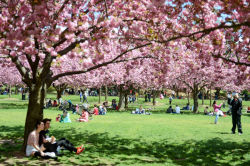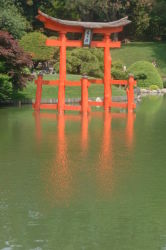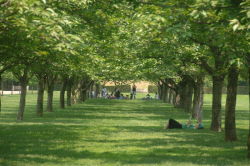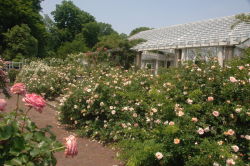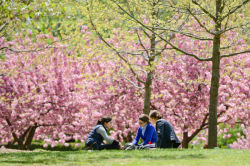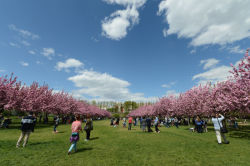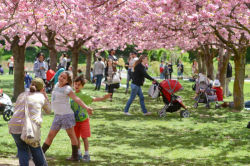Brooklyn Botanic Garden
Brooklyn Botanic Garden
What was here before?
The Wisconsin glacier that shaped Long Island, Manhattan, and the Bronx millions of years ago gave this land its unique knob-and-kettle terrain of small ponds and hills by carving depressions in the soil. Once forest and rocky farmland, the Brooklyn Botanic Garden (BBG) was transformed into one of New York City’s most beautiful parks.
How did this site become a park?
In 1864, the City of Brooklyn acquired the future site of the Brooklyn Botanic Garden (BBG) as part of its Prospect Park land purchases. Though the eastside land remained undeveloped for decades, the New York State Legislature officially established the garden in 1897. The architectural firm McKim, Mead & White designed both the Administration Building and the neighboring Brooklyn Museum of Art, which opened in 1902, with the surrounding area known as Institute Park.
The original site plan was laid out by the Olmsted Brothers, but landscape architect Harold Caparn (1864-1945) took over planning in 1912. Over the next 33 years, Caparn guided BBG’s organic growth, envisioning it as both an artistic and educational space. By the time he stepped down in 1945, the garden included more than thirteen distinct gardens, museums, and buildings.
Management of the BBG was handed to the Brooklyn Institute of Arts and Sciences in 1910, and on May 13, 1911, the Garden officially opened to the public. That same year, the Native Flora Garden, BBG’s oldest feature, showcasing plants native to the New York City region, opened. This garden was later expanded in 2013 to include coastal meadow and pine barrens habitats. The Children’s Garden opened in 1914 as a pioneering space for teaching children gardening, plant science, and healthy eating habits. In 1915, Japanese landscape designer Takeo Shiota (1881 –1943) created the Japanese Hill-and-Pond Garden, integrating it into a glacial kettle pond formed during the Ice Age. This garden underwent a major restoration in 2000.
The year 1917 marked a turning point for the Garden. The Brooklyn Botanic Garden Auxiliary was established, the Rock Garden was built using glacial boulders found on site, and the Louisa Clark Spencer Lilac Collection, with over 150 lilac species, was completed.
Expansion continued through the 1920s and '30s. The Lily Pool Terrace was completed in 1921, followed by the Shakespeare Garden in 1925, with plants referenced in the works of William Shakespeare. In 1928, the Cranford Rose Garden was unveiled with over 1,000 rose varieties. Nearby, the Magnolia Plaza was added in 1932, with seventeen different magnolia species. The nearby Steinhardt Conservatory includes the Bonsai Museum, the Warm Temperate Pavilion, the Tropical Pavilion, the Trail of Evolution, the Aquatic House, the Desert Pavilion, and the Palm House.
During the New Deal era, federal relief programs contributed to BBG’s development. In 1938, the Works Progress Administration (WPA) helped build the Herb Garden, an Elizabethan-style knot garden inspired by The Gardener’s Labyrinth. The Italianate Osborne Garden followed in 1939, constructed by labor from both the WPA and the Civil Works Administration. In 1941, Kanzan cherry trees were planted along the Cherry Esplanade, and in 1955, landscape designer Alice Recknagel Ireys (1911-2000) created Fragrance Garden, the U.S.’s first public multisensory garden designed specifically for the visually impaired.
BBG underwent a major transformation in the 1970s when it became an independent institution, separating from the Brooklyn Institute. Renovations and restorations followed in the 1990s, including work on the Rock Garden (1992), Lily Pool Terrace (1993), Fragrance Garden (1995), and soil restoration in the Cranford Rose Garden (1996). That same year, the Discovery Garden, an immersive landscape for children to explore habitats and learn about garden wildlife, opened. It was later redeveloped in 2015 to include a meadow, marsh, and woodland ecosystem.
In 2000, BBG founded the Florilegium Society to artistically document its plant collections. The Bonsai Museum was renovated in 2007, and in 2012, the Garden opened the eco-friendly Steinberg Visitor Center. In recognition of its service and innovation, BBG received the National Medal for Museum and Library Service in 2014.
BBG launched a major Water Conservation Project with the opening of the Shelby White and Leon Levy Water Garden in 2018, making BBG a national leader in sustainable water use. Accessibility was improved with the opening of the Robert W. Wilson Overlook in 2019, and in 2020, the Elizabeth Scholtz Woodland Garden opened, highlighting shade-tolerant plants suited for urban gardeners.
Brooklyn Botanic Garden is an urban botanic garden that connects people to the world of plants, fostering delight and curiosity while inspiring an appreciation and sense of stewardship of the environment. The garden is open year-round and hosts seasonal public programs year-round including special events for cherry blossom season and a winter light trail.
Check out your park's Vital Signs
Clean & Safe
Green & Resilient
Empowered & Engaged Users
Share your feedback or learn more about how this park is part of a
Vital Park System

